By Jeffrey A. Rendall, Photos by Jeffrey A. Rendall
SUFFOLK, VA – Ever walk out of an eatery wondering why you paid a hefty some for a half empty stomach full of blah tasting slop?
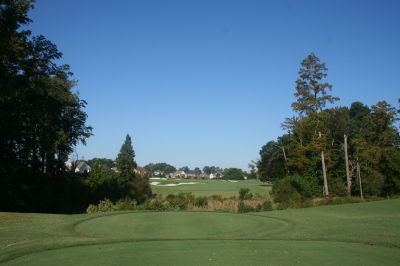 |
| It's not a very daunting carry, but the view from Riverfront's first tee (the back tees) provides a glimpse into what you'll see the rest of the way. |
That ‘walk away empty’ feeling equally applies to golf, and it’s something you’ll avoid when playing at Riverfront Golf Club in Suffolk, Virginia. The club itself is the centerpiece of a housing community, which hardly adds distinction – but when you also consider it’s the only Tom Doak designed layout in Virginia, your curiosity will start to build… along with your appetite.
Ned Twerdahl, Riverfront’s General Manager, says come to his club for your fill of golf at a reasonable price: “I never want our players to have that ‘empty’ feeling like when you pay way too much at a restaurant for food that really wasn’t that good in the first place. I want them to walk away satisfied that they were given an excellent round of golf at an affordable or reasonable price.”
Sounds like a square meal, square deal. Talk about a tried and true advertising slogan.
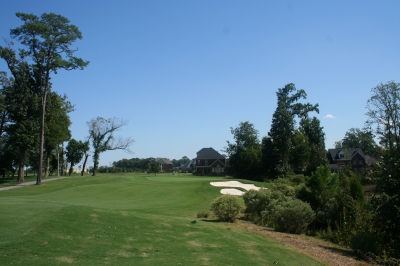 |
| Looking towards the green of the par four 17th hole -- one of the narrowest holes on the course. |
But as previously noted, playing a Tom Doak golf course is a steal at any price. Doak is probably best known for his work on Pacific Dunes at Bandon Dunes Golf Resort along the coast in Oregon (Pacific Dunes is ranked in the top ten ‘courses you can play’ in many publications’ lists). Doak believes in creating golf courses that are shaped by the land they occupy, letting the terrain dictate the layout, so you’ll get a feeling they’ve always been there. Riverfront is no different, though because of the residential element, you’ll have a hard time imagining it’s been there since the beginning of time.
Doak tells the story of how it all got started: “The project was developed by an old friend, John Gorman, who I met when I was in college traveling around to see the great courses – and he was the greens chairman at Butler National (in Illinois). The site was originally held for industrial development by Chicago Bridge & Iron Company, but when construction of the bridge-tunnel was announced (I-664, connecting Suffolk to Newport News), the property became valuable as a residential property – and John was brought on as a partner to develop it.”
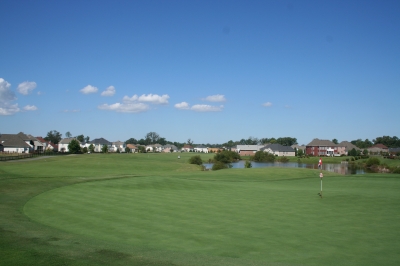 |
| The 6th green's size and undulation provides most of the challenge on Riverfront's #1 handicap hole. |
Doak mentioned his travels – he’s seen over 1,000 of the world’s greatest golf courses, and reportedly can recall every golf hole he’s ever seen. That’s a lot of detail, so it shouldn’t surprise you that Doak seeks to create golf courses that are distinct in every way.
He continues, “I first looked at the land in 1991, well before it was developed, because they had to go through a lot of environmental review concerning the use of marsh-front, and they could not commit to an overall master plan until the encroachments were approved. Then, just as we were about to start construction in 1995, CB & I was taken over by another company, which had no interest in developing real estate. It took two more years to sort that out before we even broke ground on the golf course.”
As a point of reference, Doak said his six-months-pregnant wife accompanied him on his first visit to the property, and he brought his 8 ½ year-old son to Riverfront’s Grand Opening.
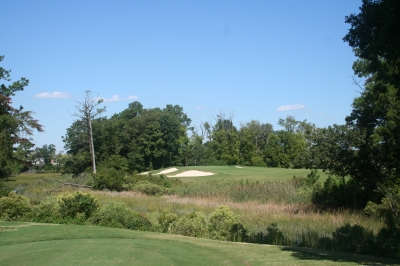 |
| There's actually a fair amount of room to land the ball on the par three 13th hole, but the target looks pretty small from the tee. |
I guess good things do come to those who wait.
In the meantime, there were several different looks at the site to work with, and not all of them were ideal. “It was a huge property and there was just tons of marsh frontage,” Doak explained. “Nearly all the elevation change was at the edges of the marsh – most of the inland property is right around twenty feet above sea level, then it goes from fifteen to five feet near the edge. Unfortunately, most of the vegetation was along the marsh-front as well – the interior was all being farmed for soybeans and had little character of its own.”
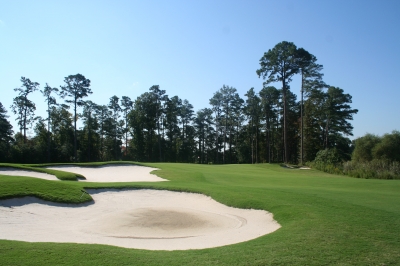 |
| At 484 yards, the par five third hole looks pretty easy on the card. But the decision on whether to lay-up or go for the green in two will be crucial. |
Flat ground may not be great for a golf course, but it works for houses. To counteract the ‘flat equals boring’ aspect, they built bunkers with very long, gentle horizon lines to get them to fit into the landscape. Visually, you’d have a hard time ever imagining that this was once a bean field -- so it works.
There were other environmental aspects to account for as well. “All of the marsh-front was protected under the Chesapeake Bay Preservation Act, and any work within 100 feet of the marsh required a special variance – which was all worked out in advance,” Doak added. “I was surprised the developer let us use as much marsh frontage as he did, but there were two factors in our favor. First, he was a good golfer and wanted a really good course, and second, he wouldn’t have been able to build homes very close to the marsh under the ordinance, so by putting golf holes along the marsh we left him more developable acreage on the interior.”
I love it when golf meets the practical, it almost leads to that mythical harmonic convergence of the elements that we’re all seeking.
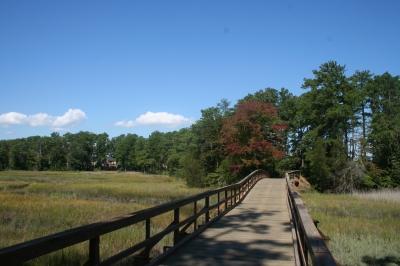 |
| This long wooden bridge spans the marsh between the front nine's two main sections -- and gives you an idea of what Tom Doak saw when he first came here. |
And while Doak helped create something unique and interesting at Riverfront, he says you won’t see any ‘trademarks’ to identify the course as one of his. “I’ve tried not to establish a trademark of my own, but my general philosophy is to give golfers wide fairways so they can find the ball and keep playing, and to make the course appealing by building interesting greens and bunkers. I remember telling Eric Iverson (Doak’s design associate at Riverfront, along with Bruce Hepner) at the beginning of the job that he should try to build the greens and greenside bunkers so each one looked and played differently, depending on whether you drove to the right side of the fairway or the left side. I think he did a great job of that, and that’s what keeps the course from getting boring after awhile.”
Though I didn’t see Riverfront until after all the real estate was already in place, I’ve heard the course in its original, ‘natural’ state was one of the best you’ll find anywhere. Even with the houses, there are a number of places that feel very part of the marsh theme, though you’re never far away from the residents. It’ll take some time for the homeowners’ landscaping to make up for the relative lack of natural vegetative barrier.
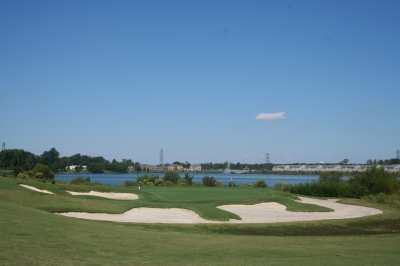 |
| The par three 11th hole is Riverfront's shortest hole (148 yards). The wind swirls and bunkers await all around if you fail to hit the target. |
Doak’s allusion to wide fairways was certainly true on most holes, and the layout is very friendly to those who typically have trouble keeping their golf balls in sight – especially on the front nine. There are a number of carries from the back tees, but there aren’t any that seem downright unfair.
It’s challenging as well. Doak says to have a serviceable golf course, you’ve got to make it hard enough to keep good players interested, yet easy enough to keep recreational golfers coming back. “With all the marsh frontage at Riverfront, there are more water hazards in play than on most any course I’ve built, but there’s always lots of space on the far side of the hole to play safely away from the trouble. It’s just hard to make pars from the wrong side of the hole,” Doak said.
Another positive aspect that Riverfront is known for is course conditioning. The greens were in excellent shape in late September, and according to word-of-mouth, that’s what you’ll find here year-round.
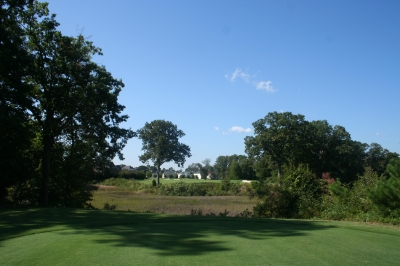 |
| Close your eyes and trust your driver from the tee of the par four 5th hole -- there's actually a lot of room out there. |
Naturally, Twerdahl is an admirer of the layout. He was more than happy to tout the course’s overall condition as well as its playability. “I’m a big fan of the entire golf course,” Twerdahl said, refusing to name a favorite hole. “I love the way it starts and finishes. Every hole is so unique that picking a few out as the best holes is difficult. One thing, again based on the undulations – is you will seemingly never play the same course twice here at Riverfront. Numerous pin placement opportunities combined with certain wind or weather conditions keep it interesting day after day.”
Twerdahl also mentioned the four sets of tees – making it enjoyable for all skill levels – again, with the back tees including several sizable carries. “It’s also semi-traditional in design, in that a long par four doesn’t have many obstacles to overcome, other than length, and conversely the short par four will demand precise approaches to have a chance to score.”
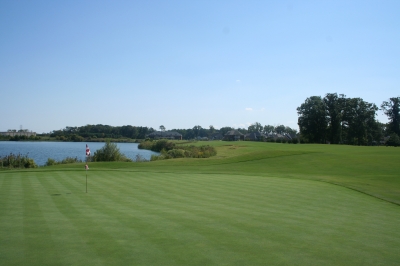 |
| The 460-yard 12th hole is Riverfront's longest par four. The water doesn't really come into play, but it's a long way home the more you try to play away from it. |
Though Twerdahl won’t name favorite holes, we will. The front side begins with a few holes through the community, then you’ll cross a long bridge over a marsh and come to the par three fourth hole. At 175 yards (from the back tee), it’s not overly long, but the view is very intimidating – there’s nothing but marsh between you and the flag. Because of the hole’s low profile, it looks longer than it plays, and fronting the green is a large bunker.
The sixth hole is Riverfront’s #1 handicap hole. 410 yards in length, you’ll need to challenge water (off the tee) on the left side and a large bunker on the right to put yourself in ideal position to approach the green. The green is huge – with different levels. Not only will you likely have a lengthy shot to the green, you’ll have to reach the correct level on the putting surface to ensure a two-putt.
On the back side, the stretch of holes from twelve to fifteen is the ‘meat’ of the course. Twelve is a beefy 460 yard par four that borders a large tidal area. The water won’t really come into play except for a big slice, but the more you play away from it, the longer the hole gets.
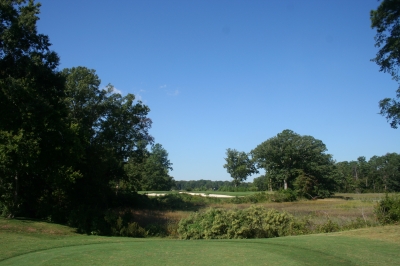 |
| The par three 4th hole (175 yards) is deceivingly long because of the green's low profile in the distance. |
Thirteen is another nerve-testing par three with a full carry over marsh and bunkers. It’s the toughest of Riverfront’s par threes.
Fourteen is a 552-yard par five that bends sharply to the left the final third of the hole. Your drive will determine how to play the second and third shots – a very interesting and challenging par five.
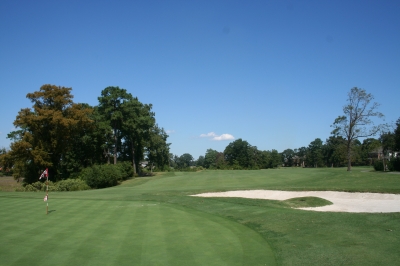 |
| The par four 15th hugs the marsh-front -- definitely a very scenic hole. |
The view from the fifteenth tee (the back tees) is perhaps the most intimidating at Riverfront. It’s a little less than 200 yards to carry the water and marsh, and if you’re not accurate, you’ll have trouble feeding it through the opening as well. Here’s a good place to see how well you’re driving the ball.
Riverfront Golf Club is one of those that you don’t hear a lot about, but certainly adds to the overall quality of golf in southeastern Virginia. Thanks to the I-664 bridge/tunnel, it’s a fairly easy drive from points north, and even from the Williamsburg area.
One thing’s for sure, you won’t walk away feeling ‘hungry.’ Your golf appetite will be more than satisfied.
Details:
Riverfront Golf Club
Tee Times: (757) 484-2200
Website: riverfrontgolf.com
Course Designer: Tom Doak
General Manager: Ned Twerdahl
Tees/Yardage/Slope/Rating
Blue 6753 129/72.5
White 6357 126/70.3
Green 5891 119/68.0 123/73.6 (L)
Red 5259 117/69.7
Rates:
$40-$45 during the week. Senior rate is $27.
Weekends are $10 higher.
Twilight rates available, $10 off.
| Related Links | Comments on this article? | |
|
Maryland National Golf Club Hollow Creek Golf Club Rocky Gap Resort PB Dye Golf Club in Ijamsville Whiskey Creek Golf Club |
E-mail Jeff Rendall, Editor: jrendall@golftheunitedstates.com |











